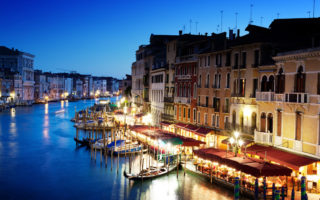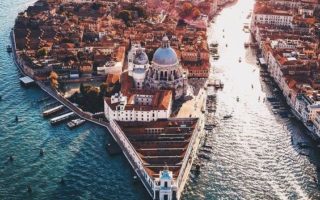Off the Beaten Track: The Best Things to Do in Venice
Known famously and fondly as the “Floating City”, for centuries Venice functioned as the financial gateway between the East and the West. From the banks of its canals and mudflats stretched a sprawling empire whose territory spanned from Cyprus and the southern Peloponnese right up to the Dolomites in the north. And, working as both the beating heart and the muscle of this mercantile superpower was Venice’s fearsome fleet, to which, at its apex, one fully fitted out warship could be added every, single, day.
Visit Venice today and you’ll see that the city is still run by enterprising merchants. But as Venice’s fortunes have faded, so have its residents been forced to adapt. To make sure their “City of Water” hasn’t gone under with the coming of the modern age, they have abandoned their former wares of textiles and spices to take up a new trade in tourism. And they’ve taken to this trade like ducks to water; for as even the most fleeting of visits to the regional capital of Veneto will make perfectly clear, Venice’s tourist industry is absolutely booming.
 |
| Tourists in the Piazza di San Marco |
Venice’s main selling point—and, although locals are reluctant to admit it, the city’s main economic lifeline—is the quality and quantity, of its attractions. Many vestiges of Venice’s former glory are household names: from the picture postcard Rialto Bridge to the imposing medieval Doge’s Palace right across the lagoon to the glass-blowing island of Murano (whose glassmiths paid a steep price for their prestigious lifestyles in never being allowed to leave the Republic). And at the centre of it all stands Europe’s most ornate cathedral, a basilica purpose built to house the body of a stolen saint: St Mark’s Cathedral.
 |
| Burano, the island of glassmiths, by boat |
But the best things to see in Venice lie beyond the main tourist attractions. They lie buried beneath the city’s slowly sinking churches, situated on one of the dozens of islands dotted across the Venetian lagoon, or subsumed within the crumbling palazzithat line the Grand Canal. And this is something that few first-time visitors never really appreciate: that it isn’t the awe-inspiring monuments that are the real gems of the city. It’s the overshadowed and often crumbling relics that really capture the heart of the city.
 |
| The Grand Canal |
Such is Venice’s charm that you could happily while away your time meandering its winding walkways or navigating its labyrinthine waterways. But so that you don’t miss any of Venice’s hidden highlights, we’ve prepared some off the beaten track suggestions—on offer either through one of our tailored tours or our Venice walking tour—that take you through some of the lesser known (but absolutely worthwhile) places to visit on Venice’s main island and on the others spread out across the lagoon.
Top things to do in Venice
Starting off in the north of Canareggio on Venice’s main island, the Church of Madonna dell’Orto (or “Mary of the Vegetable Garden” in English) is often overlooked by tourists who tend to gravitate more towards Venice’s main attractions south of the Grand Canal. This is surprising considering the church’s historic pedigree. For not only does it represent perhaps the finest example of gothic architecture of any church in Venice, but the inside impresses just as much as the outside with numerous paintings by Tintoretto lining its walls—less surprising than you might think, given that this was the great artist’s local parish church and is now his burial place.
 |
| The Church of Madonna dell’Orto |
Walk a few minutes southwest of the church and you’ll come to the Campo di Ghetto Nuovo, or the historic Jewish Ghetto. From 1516 the small island served as the main neighbourhood for Venice’s swelling Jewish population until 1797, when Napoleon pulled down the ghetto’s gates. The Jewish Museum is a great place to start, but the best way to explore the area and its many resplendent synagogues is by taking one of our customized tours.
 |
| Venice’s Jewish Ghetto. Photo credit: NY Times |
Tourists tend to neglect the Church of San Zaccaria in favour of its bigger brother, St. Mark’s, to the northwest. But the church at the head of the square of the same name houses some of the best hidden wonders in Venice. Behind its quintessentially Venetian façade, which blends a beautiful mixture of renaissance and gothic styles, is a Bellini altarpiece: the Madonna and the Four Saints.
But it’s what lies beneaththe church that really deserves a visit: An aquatic house of mirrors in which the permanent waterlogging creates the illusion of a space at least twice the size, the ninth century Flooded Crypt of San Zaccaria is the final resting place of eight of the city’s early medieval rulers (doges). Head left outside the church, and in less than a minute you’ll arrive at the San Zaccaria vaporetto (water bus) stop. From here hop onto vaporetto #1: it’s time to take to the water.
 |
| The sunken crypt of San Zaccaria. Photo credit: Tripadvisor |
Best Venice islands to visit
No trip to Venice would be complete without taking a boat tour. Whether by gondola, by vaporetto, or—if you’re willing to shell out for one of the most expensive taxis in Europe—by private water taxi, you have to see the Grand Canal and the attractions that line it as they’re meant to be seen: from below. But Venice is much more than the canals and waterways of its main island. To get a real feel for the “City of Water”, you have to cross the lagoon.
 |
| View over the Grand Canal |
Most of Venice’s visitors make the short boat trip on the #41, #42, or #LN (North Lagoon) to the glass-blowing island of Murano. Some make the slightly longer trip on the #LN to the much more beautiful island of Burano which, with every one of its pastel houses painted a different colour so its residents could identify them through the fog from far out at sea, is perhaps the most colourful island in the world. But few venture further out to discover some of the more underrated islands in the Venetian lagoon.
 |
| The pastel-coloured houses of Burano |
An hour’s boat ride north of Venice’s main island, or a quick shuttle boat’s ride from the northern island of Burano, lies the the largely abandoned island of Torcello. The island generates remarkably little interest among tourists considering it’s the place where Venetian history all began. Torcello was the first island in the Venetian lagoon to be settled back in the fifth century, and by the fourteenth century its population numbered a staggering 20,000.
The place of worship for its islanders was the Cathedral of Santa Maria dell’Assunta, some of the remains of which date back to the seventh century. The church still holds pride of place as the oldest building in the lagoon. But it didn’t serve its historical population for long. By the fifteenth century Torcello had become overrun with malaria, and demographically it never recovered. Only around 30 people now live on the island.
 |
| Cathedral of Santa Maria dell’Assunta. Photo credit: Italian ways |
Another famous site on Torcello is its Ponte del Diavolo or “The Devil’s Bridge”. According to legend, the bridge was built in one night (the devil of folklore is always credited with 24-hour turnaround jobs, so it must be a relief to Christians worldwide that Rome wasn’t built in a day). Still, at least it’s Antichrist’s intervention rather than the slapdash nature of local bridge building methods that the locals can use to explain why their bridge doesn’t have any railings.
 |
| “The Devil’s Bridge”. Photo credit: Mike’s Travel Guide |
If you’re planning to visit in summer, the largest island in the lagoon, Sant’Erasmo, is well worth a stop. Sometimes called “the Market Garden of Venice”, it’s home to some of the freshest artichokes and asparagus in Italy. Be sure to pack your own picnic: the island is rarely frequented by tourists and so is lacking in bars and restaurants to accommodate. But as there are strict bylaws that prohibit you from picnicking in the parks of Venice’s main island, you may want to seize the opportunity while you can.
Best restaurants in Venice
Something worth remembering in Venice is that people eat early, so try not to turn up for dinner later than 8.30pm. That said, don’t let this put you off your aperitivo. In Venice there’s always time to andemo in ombra(or “go into the shade” as the Venetian’s say) and indulge in a little pre-dinner glass of wine at one of the city’s many bacari, or wine bars.
 |
| Baraceto da Lele. Photo credit: TripAdvisor |
Across from the Church of San Nicola on the western edge of Tolentino is one of Venice’s best bacari, Da Lele. Something of a Venetian institution, the bar is always abuzz with locals, and with every passing year its offerings are being discovered by more and more tourists. With its delicious range of chiceti—aperitivo-type food consisting of seafood, artichoke hearts, and small meatballs for example—and such reasonable prices (small glasses of wine starting at €0.60), it’s little wonder.
We’d suggest you steer clear of restaurants in the vicinity of Piazza San Marco: their prices tend to be inflated and they rarely reflect the quality of the food. Head a few minutes north to the Rialto area, west across the Grand Canal to the trendy district of Dorsoduro, or to the northernmost neighbourhood of Cannaregio and you’ll find the choices increase considerably.
 |
| Piazza San Marco: Beautiful views but there are better places for food! |
For a restaurant situated just a few minutes away from the Rialto Bridge, Osteria Alle Testiere is fiendishly hard to find. Quite typically for Venice, it lies tucked away in one of the city’s central narrow streets, close to a little bridge that leads to a quaint church. But with its fresh delicious seafood, and simple yet intimate ambiance, Osteria Alle Testiere is one of Venice’s most valuable hidden treasures. As it can only seat 24, just make sure you book ahead to avoid disappointment.
 |
| Taglietelle at Osteria alle Testiere. Photo credit: TripAdvisor |
If you’re looking for something sweet, and you happen to be in the Cannaregio district, check out Venice’s leading crêperie, Cocaeta. It hasn’t been going for long. But its extensive list of sweet (and savoury) pancakes, all lovingly prepared by its owner, Giulio, keep a loyal clientele coming back time and time again.
When to visit Venice
While Venice doesn’t really have an off-season, there are still times to avoid. Peak season runs from April through to October and during these months the city centre can feel full to capacity. Be aware that unless you book way in advance, securing some of the best accommodation in Venice can be difficult in this period as places tend to fill up. If you are however set on the spring and summer season, you’re best off aiming for the beginning or the end; soaring summer temperatures in July and August can make the Venetian lagoon seem more like a stifling swamp than the “Queen of the Adriatic”.
 |
| A rainy night in Piazza San Marco |
If you’re looking for peace and quiet, try either coming to Venice in November (where you can catch the end of the world-famous Biennale) or visiting Venice in March. You might have to put up with a spot of rain, but fewer crowds give a greater sense of having the city all to yourself. Which is a feeling you get especially at night.
Winter nights are the most atmospheric in Venice. Lost in fog and lamplight, and with only the sound of cobbled footsteps to guide you, you can very much feel like you’re in a scene from Nicholas Roeg’s 1973 classic “Don’t Look Now”—in which, alongside Donald Sutherland, Venice undoubtedly plays the lead role. But it’s not all eerie: head to one of Venice’s northernmost islands on a brisk winter’s day, and you can see straight across the lagoon to the sublime snow-capped Alps looming in the distance.
Roman Candle Tours in Venice
If some of these sites sound right up your street, why not check out our range of Venice tours! For those of you visiting Venice for the first time, our expert guides offer in-depth coverage of the city’s two main sites in our St Marks and Rialto Bridge Tour, while if you’re looking to take to the water and experience the city at its most picturesque check out our Venice Evening Boat and Walking Tour.
 |
| A quiet street on the northern island of Burano |
And if one of the sites or attractions in this article have caught your eye, or you think we’ve left something out, be sure to leave a comment below and get in touch. We’ll be sure to incorporate it into one of our future blog posts. Or, if you’re thinking of visiting Venice and want to experience it for yourself, we’ll make sure we include it in one of our personalised tailored tours. After all, we at Roman Candle Tours are here to make sure you get everything you want out of your trip to Italy.
If you liked this article, you can also read “Secret Venice: the 5 Most Underrated Islands in the Venetian Lagoon“





